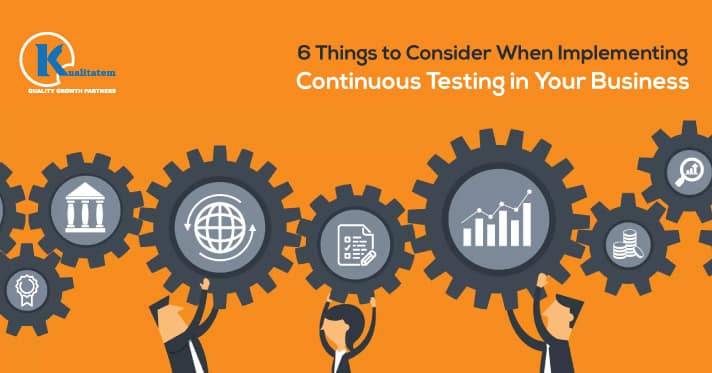Implementing Continuous Testing: 6 Key Considerations for Your Business

- December 27, 2018
- HibaSulaiman
Nowadays, businesses are mostly software-driven. In order to provide a high-quality user experience to their customer base, they need to ensure that everything is seamless. However, it depends largely on how software development teams deliver an uncompromised quality of digital experiences to their customers within the estimated delivery time. Although quality and speed may seem completely opposed, there’s a way we can achieve these both and that’s through continuous testing.
Continuous testing is rather a new software testing practice that enables faster time to market. The core purpose of continuous testing is to implement automated tests all through the software development cycle rather than having to wait until the end of the development process.
Seeing our experience, there are 6 things that we believe businesses need to consider when implementing CT to ensure success:
1. Cultural commitment to quality
Here’s the trick is to commit to sustaining high-quality, working code as a priority, instead of only fixing quality issues after problems have piled up. When quality is sustained at all times, productivity increases twice fold, and less time is spent on modifications, confusions, or even possible unexpected delays.
Quality enables speed in software development. Accomplishing a cultural commitment to quality involves buy-in from all teams. One way to reach buy-in is to show that senior management is dedicated to executing quality throughout the software development lifecycle. When management shows commitment apart from pushing product to production, it spreads throughout the organization.
Another way to accomplish buy-in is to confirm that team members are accountable for quality and should work on areas for improvement. Permitting team members to provide input on product quality constructs a more cooperative culture that’s dedicated to sustaining quality.
2. Testing strategies modified for every phase of the development cycle
By testing code earlier within the SDLC and also more often, teams can identify issues and fix them earlier in the development process. This helps the business deliver software in a much faster way, in order to shun any possibly ruinous defects that can cause a fortune if identified later. It’s important to use a diversity of testing strategies to inspect the code at different levels during different phases of the development cycle.
These tests will differ depending on the team’s needs. However, they can range from unit tests designed precisely for single segments of code to the end-to-end testing of code in production, ensuring that your product functions as planned.
3. Employing knowledge and proficiency to build out automation
The earlier test automation tools focused on speeding up what was previously a slow and time-consuming process. Back then, automated tests were thought as an enormous improvement — test reliability was a minor concern at best.
Nowadays, the paybacks of implementing a fully automated test suite into the software development process are obvious. Developers gather rapid feedback on problems and can work in smaller, more expectable increments. Testing for quick feedback has huge benefits, though poor test quality can be time-taking.
Well-written, reliable tests are inevitable, and producing them requires some knowledge and proficiency. For successful results, teams should have automated testing experts in the team. Once automation testing is executed throughout the development process, manual testers are free from performing repetitive tasks to emphasize more on innovative exploratory testing and usability testing solutions.
4. Test execution platform that offers a comprehensive coverage
For understanding the benefits of continuous testing, it’s crucial to have a steadfast, high-quality test execution platform that provides access to the web as well as mobile platforms. Your app should be able to flawlessly function on new as well as old versions of iOS, Android, macOS, and Windows in a similar fashion. Cloud-based services can help easily keep up with the latest platforms available in the market, hence allowing your team to concentrate on innovation.
5. Test execution platform that scales up and down instantly as required
For maximum flexibility, you need a test execution platform that is easily scalable — whether that’s allowing for large volumes of testing before any important release and scaling down after, or being able to scale according to the growing customer base and platform compatibility needs.
Scaling test infrastructure is most certainly costly and complex. Companies should estimate build versus buy strategies to regulate scaling of testing efficiently and successfully. Cloud solutions for continuous testing allow teams to scale test execution without the trouble of preserving the infrastructure, allowing teams to focus on developing applications.
6. Visibility and analytics
Finally, similar to any critical part of a software development pipeline, testing should be measured for easily optimizing it. Using analytics is crucial for comprehending how successfully tests perform and quickly identifying bottlenecks for checking quality issues. Teams need clear visibility into the productivity and reliability of the testing processes for quick, comprehensive and dependable tests.
While looking over test analytics, teams need to consider any recurring patterns and trends, i.e., what browsers and mobile platforms consistently fail, when a test fails, if test results are consistent throughout under different testing environments?
When implemented properly, continuous testing offers endless benefits to developers, businesses, and customers. Since your business needs to come up with innovative ways to stay ahead in the competition, it can help you accomplish maximum success in your market.
With improved testing strategies, your business will have the ability to market higher-quality products faster, and efficiently provide innovative experiences to your customers.











